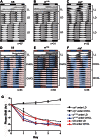Cycles of circadian illuminance are sufficient to entrain and maintain circadian locomotor rhythms in Drosophila
- PMID: 27883065
- PMCID: PMC5121609
- DOI: 10.1038/srep37784
Cycles of circadian illuminance are sufficient to entrain and maintain circadian locomotor rhythms in Drosophila
Abstract
Light at night disrupts the circadian clock and causes serious health problems in the modern world. Here, we show that newly developed four-package light-emitting diodes (LEDs) can provide harmless lighting at night. To quantify the effects of light on the circadian clock, we employed the concept of circadian illuminance (CIL). CIL represents the amount of light weighted toward the wavelengths to which the circadian clock is most sensitive, whereas visual illuminance (VIL) represents the total amount of visible light. Exposure to 12 h:12 h cycles of white LED light with high and low CIL values but a constant VIL value (conditions hereafter referred to as CH/CL) can entrain behavioral and molecular circadian rhythms in flies. Moreover, flies re-entrain to phase shift in the CH/CL cycle. Core-clock proteins are required for the rhythmic behaviors seen with this LED lighting scheme. Taken together, this study provides a guide for designing healthful white LED lights for use at night, and proposes the use of the CIL value for estimating the harmful effects of any light source on organismal health.
Conflict of interest statement
The authors declare no competing financial interests.
Figures





Similar articles
-
Phase coupling of a circadian neuropeptide with rest/activity rhythms detected using a membrane-tethered spider toxin.PLoS Biol. 2008 Nov 4;6(11):e273. doi: 10.1371/journal.pbio.0060273. PLoS Biol. 2008. PMID: 18986214 Free PMC article.
-
Cyclic presence and absence of conspecifics alters circadian clock phase but does not entrain the locomotor activity rhythm of the fruit fly Drosophila melanogaster.Chronobiol Int. 2011 Jul;28(6):497-508. doi: 10.3109/07420528.2011.591018. Chronobiol Int. 2011. PMID: 21797778
-
Light and feeding entrainment of the molecular circadian clock in a marine teleost (Sparus aurata).Chronobiol Int. 2013 Jun;30(5):649-61. doi: 10.3109/07420528.2013.775143. Epub 2013 May 20. Chronobiol Int. 2013. PMID: 23688119
-
Circadian Rhythms and Sleep in Drosophila melanogaster.Genetics. 2017 Apr;205(4):1373-1397. doi: 10.1534/genetics.115.185157. Genetics. 2017. PMID: 28360128 Free PMC article. Review.
-
Photic entrainment in Drosophila assessed by locomotor activity recordings.Methods Enzymol. 2015;552:105-23. doi: 10.1016/bs.mie.2014.10.017. Epub 2014 Dec 26. Methods Enzymol. 2015. PMID: 25707274 Review.
Cited by
-
Precision Light for the Treatment of Psychiatric Disorders.Neural Plast. 2018 Jan 11;2018:5868570. doi: 10.1155/2018/5868570. eCollection 2018. Neural Plast. 2018. PMID: 29593784 Free PMC article. Review.
-
A scalable culturing system for the marine annelid Platynereis dumerilii.PLoS One. 2019 Dec 5;14(12):e0226156. doi: 10.1371/journal.pone.0226156. eCollection 2019. PLoS One. 2019. PMID: 31805142 Free PMC article.
References
-
- Fulle M. C. M.-E. F. M. S. C. A. The Clocks That Time Us: Physiology of the Circadian Timing System. Harvard University Press (1984).
-
- Hastings J. W., Rusak B. & Boulos Z. Circadian rhythms: the physiology of biological timing. 4th edn, 435–546 (New York: Wiley-Liss, c1991., 1991).
-
- Dunlap J. C. Molecular bases for circadian clocks. Cell 96, 271–290 (1999). - PubMed
Publication types
MeSH terms
Substances
LinkOut - more resources
Full Text Sources
Other Literature Sources
Molecular Biology Databases

